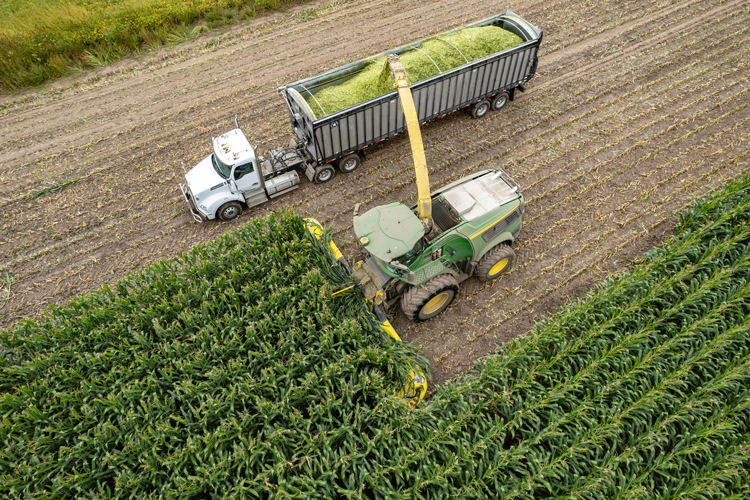
Self-propelled forage harvesters can adjust on the go, corresponding with data being collected as the crop is harvested. Many of these powerful machines are equipped with moisture sensors. With constant moisture measurements coming in as we chop corn, the forage chop length can be adjusted automatically to match the rate of crop drying with greater maturity.
From a nutrition perspective, more mature corn silage typically carries less digestible fiber. Less digestible fiber leads to lower dry matter intake potential in dairy or beef cattle, though this negative can be partly offset by chopping the fiber shorter. Hence, the moisture-driven automated chop length function is valuable.
The automation is straightforward, and the engineering advancement was driven by a simple correlation rooted in two data sources and human intelligence. It’s relatively simple to understand how these adjustments can be made based upon an “if this, then that” model. Keep this simple model approach in mind as we take a step off the diving board into the deep learning-model ocean with relation to forage production and quality.
Paving the way
Stepping beyond human insights and into the artificial intelligence (AI) space, AI has infiltrated many aspects of our lives. There is an AI assistant nested within many different day-to-day applications. It’s taken me several years to somewhat grasp how this works. But now I hopefully carry enough experience with AI empowered projects to offer you my insights and project how we’ll be using AI-driven models in the months and years to come.
Forage yield and quality are often inversely related — but sometimes they’re not. We know that heat units, moisture amount and timing, soil type, fertility, seed genetics, crop protection, crop rotation, and many other factors affect yield and quality.
In nearly 20 years out of graduate school, my experience-driven human intelligence has advanced to the point that I understand how a few of these factors may influence yield or quality each year. However, like a weatherman projecting the forecast, I’m still often wrong. Therefore, I predict that the path toward concretely projecting annual yield and quality outcomes, or making better harvest decisions relative to all the factors described above, will be paved by deep learning models and driven by big data.
Building models
Comparing and contrasting my human experience with AI, observations drive the learning. A forward-thinking dairy owner recently showed me some harvest mapping where we not only saw corn silage moisture and yield, but we also got weather, corn hybrid, and some basic nutritional information in the database.
Reflecting on the “if this, then that” type of model described above for corn silage chop length, there’s no way humans can build a simple linear regression model with these five different data sources for all farms. However, deep machine learning models can, and will. We’re not there yet, but we’re getting closer.
Think of advancing AI like a child learning from day-to-day experiences. Machine learning models have a thirst for data to drive their user experience. There are numerous big data tables on farms today. The information is there; however, it’s not yet connected.
The first step forward in any AI-driven modeling is aggregating and structuring the data such that the machine learning can be unleashed. This is a huge step, involving big investments in software engineering and database management. There is still a sizable canyon to cross here, despite millions of data points existing now on any given farm. But the data isn’t connected like it needs to be.
Following data integration, deep machine learning modeling can interpret relationships between data sources such as weather, crop protection, and soil fertility that humans can’t uncover. This is how models are built. These models then serve to generate outcomes humans couldn’t have predicted, and management can be refined.
Real-life applications
Think of the AI model forecasts and alerts like a check engine light, letting you know something is wrong and needs to be addressed before a catastrophe happens. This is similar to the way smartphones interpret your daily usage and suggest different apps for you to open at various times of day. Now, imagine a growing season where AI-driven models can determine exactly which field needs to be chopped first, without even checking moisture or maturity.
We could avoid jumping from field to field after opening up or chopping through the middle of fields to check moisture. This would alleviate a major pain point and is just one example of what we are chasing after in the future of AI.
We’ve been automating decision making such as chop length for years. The complexity and automation will rapidly advance in months and years to come, improving as we advance in database management. Until then, ask your farm advisers how they’re using AI in their work, and explore different AI-backed solutions for your operation.
This article appeared in the November 2025 issue of Hay & Forage Grower on page 26.
Not a subscriber? Click to get the print magazine.

